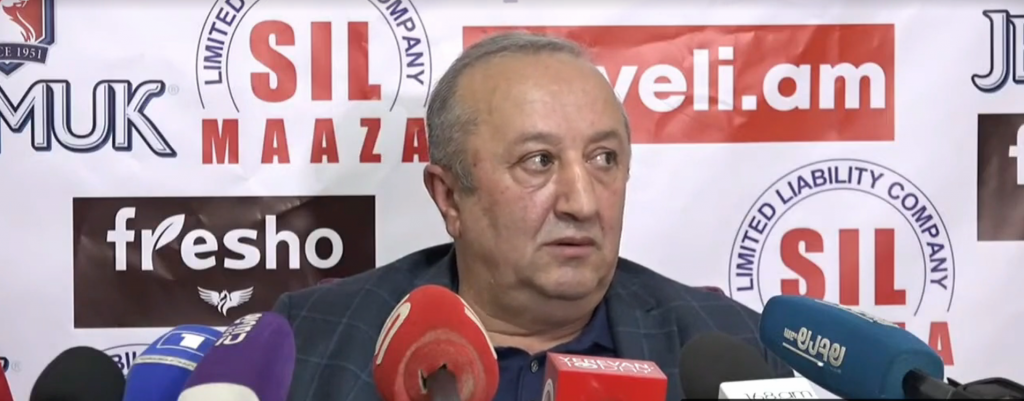Former Armenian Commander Who Blasted Government Failures During War Is Now Under Investigation
The former head of the Armenian Ministry of Defense’s Military Control Service, Colonel General Movses Hakobyan, was summoned yesterday by Armenia’s Special Investigation Service for comments made during a press conference on the same day. He has since been released after a 40 minute stay to explain his statements in the SIS building in Yerevan.
His summoning comes after an advisor to the Prosecutor General of Armenia, Gor Abrahamyan, stated on his Facebook page that the press conference had been recorded by the Prosecutor General’s office and sent to the SIS for investigation under Articles 180-181 of Armenia’s Criminal Code, in addition to verification of his claims. A similar statement was made to News.am by a spokesperson for the Prosecutor General’s office.
In a wide-ranging press conference yesterday, the Colonel General said that he resigned after discovering a Facebook post by Pashinyan that urged soldiers on the frontlines to return to Yerevan to “solve the problems” of protesters that took to the streets after the announcement of the tripartite peace deal.
Hakobyan faulted many aspects of Armenian strategy for their defeat, starting with incompetent management of the Armenian armed forces during the transition from peacetime operations to combat operations. He claimed that management competence began its decline with the appointment of Artak Davtyan, Chief of the General Staff of the Armenian Armed Forces between May 2018 and June 2020, saying that he had described Davtyan to Prime Minister Pashinyan at the time as “the most unprepared general”, following Hakobyan’s own sacking as Chief of the General Staff.
He continued by excoriating the Armenian military information center’s efforts to mislead the enemy through information warfare, saying that there was a principle of information warfare that “30% (of what we release) is false information, and the rest is true. But our false information was more than 100%.” He added that the blatant nature of the disinformation made it unconvincing to the enemy, and instead left Armenian soldiers and the Armenian public at a loss as to why the peace deal was signed.
Hakobyan next claimed that the mobilization process was done inefficiently, saying that as at the 30th October, 70% of forces in the Republic of Artsakh and 52% of forces in the Republic of Armenia had been mobilized, despite plans calling for mobilization to be completed in 48 hours from the declaration of hostilities. Instead, he claims, Pashinyan ordered a halt to mobilization of regular soldiers on the third day of fighting, with volunteers sent to the frontlines instead, with inadequate equipment and weapons, adding that he had a voice recording of the order. He continued that 1,500 soldiers had deserted by the fifth day of fighting, with manpower needing to be dedicated to keep deserters in Nagorno-Karabakh instead of escaping to Armenia and spreading panic there.
Hakobyan then claimed that the manpower shortage was exacerbated by a 98% increase in headcount at the Ministry of Defense and General Staff following the 2018 Velvet Revolution that saw the election of Pashinyan and Hakobyan’s sacking, saying that this reduced the actual combat manpower available. He said that most of his time in command of forces in Nagorno-Karabakh was keeping non-military personnel out of HQ, including Pashinyan’s wife, Anna Hakobyan, who had previously stated she would be heading to the frontlines in an all-female volunteer squad. He alleged that four hours after he asked her to leave, he was called back to Yerevan and not allowed to return to Nagorno-Karabakh.
However, he saved his vitriol for the now-former Press Secretary for the Armenian Ministry of Defense, Artsrun Hovhannisyan, describing him as having “lied 30 times a day”. He said that Hovhannisyan had been assigned to analyze the fighting despite the highest point of his military service being command of a platoon.

Hakobyan then criticized the equipment procured by the Armenian military since 2018, saying that they were unsuited for modern conflicts compared to what had been previously planned. He said that the Su-30SMs, “obsolete” 9K33 Osa (NATO reporting name SA-8 Gecko) short range SAM systems and towed ZU-23-2 anti air guns procured did not fire any shots in anger, claiming that the Su-30s were not equipped with suitable weaponry due to a Russian special decree restricting exports of missiles. Any Azerbaijani drones that were shot down were instead shot down with Tor missile systems (SA-15 Gauntlet) or Igla MANPADS. In response to a question, he said that Iskander ballistic missiles had been used during the fighting, but he did not know the details.
Hakobyan also criticized Armenian Minister of Defense Davit Tonoyan for his failure to ensure that adequate weapons reserves existed for combat. Instead, Russia supplied weapons and equipment without the involvement of the Ministry of Defense. Hakobyan said that “Russia provided the maximum it could have. We should be grateful. It gave us that which we could only dream about”, including Pole-21 electronic warfare systems which were able to keep Turkish drones at bay for four days, before system changes to the drones overcame the counter-measures.
While Hakobyan’s various comments suggest a near total dysfunction of the Armenian command that made defeat inevitable, it should be noted again that he would have an axe to grind with the current Armenian government, owing to both his original sacking by Pashinyan and the apparent dispute with Pashinyan’s wife. With public anger continuing, Hakobyan may just be the first of many senior governmental figures airing dirty laundry to redirect anger away from them or to settle scores.

